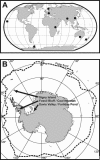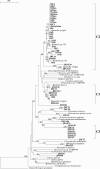Evidence for geographic isolation and signs of endemism within a protistan morphospecies
- PMID: 16885260
- PMCID: PMC1538753
- DOI: 10.1128/AEM.00601-06
Evidence for geographic isolation and signs of endemism within a protistan morphospecies
Abstract
The possible existence of endemism among microorganisms resulting from and preserved by geographic isolation is one of the most controversial topics in microbial ecology. We isolated 31 strains of "Spumella-like" flagellates from remote sampling sites from all continents, including Antarctica. These and another 23 isolates from a former study were characterized morphologically and by small-subunit rRNA gene sequence analysis and tested for the maximum temperature tolerance. Only a minority of the Spumella morpho- and phylotypes from the geographically isolated Antarctic continent follow the worldwide trend of a linear correlation between ambient (air) temperature during strain isolation and heat tolerance of the isolates. A high percentage of the Antarctic isolates, but none of the isolates from locations on all other continents, were obligate psychrophilic, although some of the latter were isolated at low ambient temperatures. The drastic deviation of Antarctic representatives of Spumella from the global trend of temperature adaptation of this morphospecies provides strong evidence for geographic transport restriction of a microorganism; i.e., Antarctic protistan communities are less influenced by transport of protists to and from the Antarctic continent than by local adaptation, a subtle form of endemism.
Figures



References
-
- Barker, P. F., and E. Thomas. 2004. Origin, signature and palaeoclimatic influence of the Antarctic Circumpolar Current. Earth-Sci. Rev. 66:143-162.
-
- Boenigk, J. 2005. Some remarks on the strain specificty and general pattern in the ecology of Spumella (Chrysophyceae). Nova Hedwigia 128:167-178.
-
- Boenigk, J., and H. Arndt. 2000. Particle handling during interception feeding by four species of heterotrophic nanoflagellates. J. Eukaryot. Microbiol. 47:350-358. - PubMed
-
- Boenigk, J., K. Pfandl, P. Stadler, and A. Chatzinotas. 2005. High diversity of the “Spumella-like” flagellates: an investigation based on the SSU rRNA gene sequences of isolates from habitats located in six different geographic regions. Environ. Microbiol. 7:685-697. - PubMed
Publication types
MeSH terms
Substances
Associated data
- Actions
- Actions
- Actions
- Actions
- Actions
- Actions
- Actions
- Actions
- Actions
- Actions
- Actions
- Actions
- Actions
- Actions
- Actions
- Actions
- Actions
- Actions
- Actions
- Actions
- Actions
- Actions
- Actions
- Actions
- Actions
- Actions
- Actions
- Actions
- Actions
- Actions
- Actions
Grants and funding
LinkOut - more resources
Full Text Sources
Molecular Biology Databases

